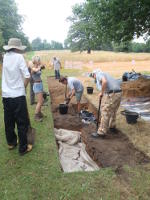18 Jul 2014
Festival Of Archaeology 2014 - Forty Hall - Day 4

Despite thunderstorms overnight, the ground quickly dried out today and the summer heat continued to make work very difficult for our diggers.
Yesterday's half-width trench extensions were today widened to the full width of trench one while the south end of the trench containing the shallow rubble-filled ditch feature was backfilled and re-turfed, having been fully recorded.
The north end of the trench contains a complex mixture of rubble and brickearth dumps, which at the moment seem to be part of one large deposit filling yet another linear feature such as a ditch, albeit much deeper than the one we backfilled today.

Amongst the ubiquitous demolition rubble we have had several interesting finds, including several fragments of a stoneware jug or bottle, featuring an unusual pattern of oak leaves and acorns (or possibly thistles -- pictured). Metal-detecting the spoil also discovered a small lead seal with a faintly visible inscription ending in '...cres' -- identifying and (hopefully!) dating this will be another post-excavation job.
There were also several fragments of window glass in the rubble today and also a few pieces of apparently glazed roof tiles (unusual for this site) -- yet more evidence of a full building rather than just a wall nearby although as yet still no sign of the building itself.

The mixed rubble deposit has not yet been fully excavated so we do not yet have a good idea as to its depth or the shape of the cut it fills, but already the possibility has been raised of a palace moat -- this would be just as good as a wall, in a way, since it would serve just as well to help define the boundary of the palace precinct, and also because conclusive evidence of the palace moat has not been seen for at least fifty years!
The forecast for tomorrow is for more rain and provided it isn't too heavy it might actually make our work easier -- baking sunshine makes deposits dry and dusty and very difficult to interpret.